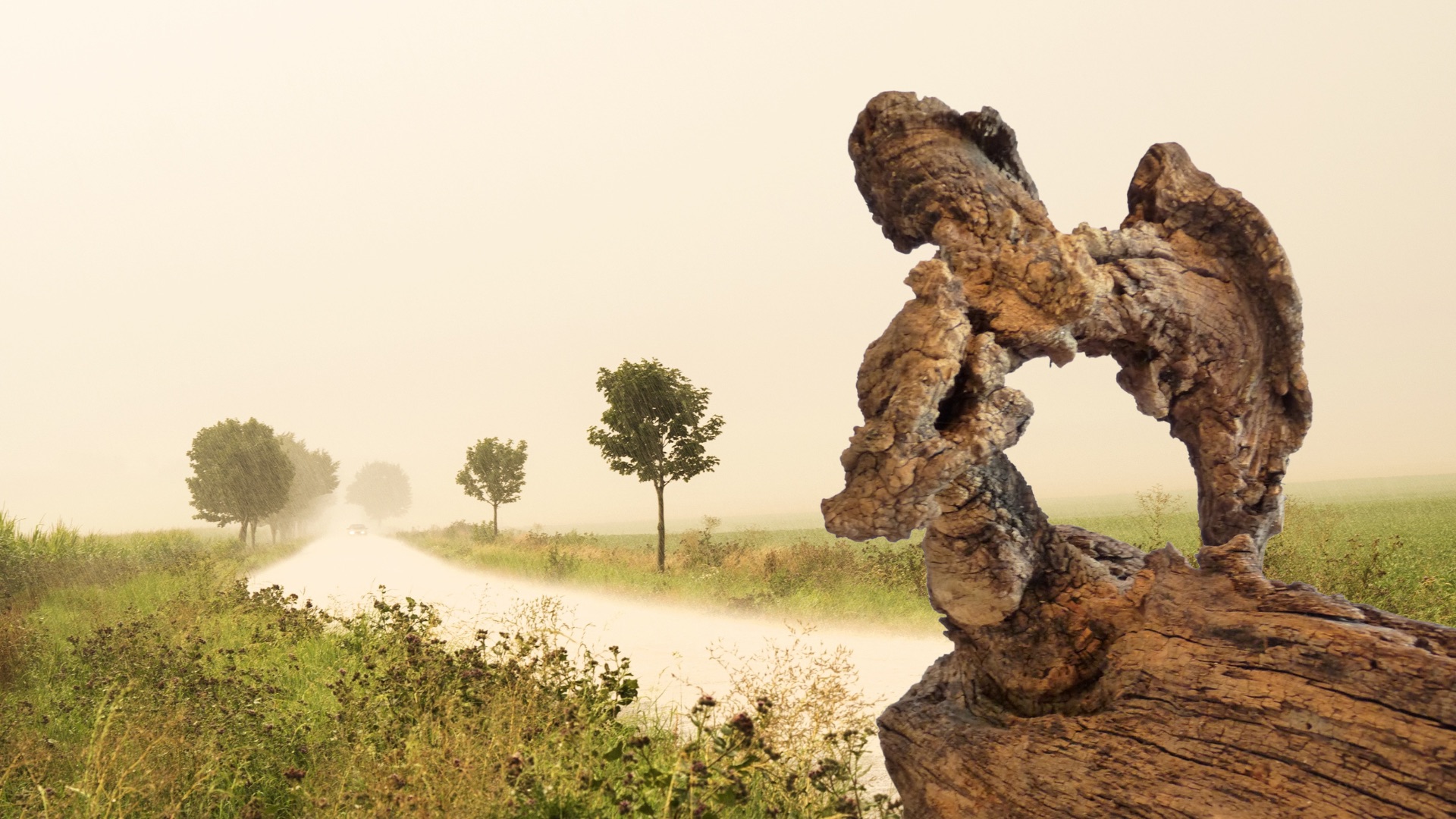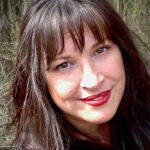
This Log Shall Not Be Moved
Sometimes, we need a talisman to remind us of the difference between who we used to be and who we are now. In Rachel Martin's house, it's a log. A very particular log.
A few summers ago, I returned to the place that raised me. It wasn’t a long trip, just 18 minutes down Highway 96E, but I’d refused to go back, believing the memory of home needed to be inviolable. On this day, though — a hot July day a scant month before my 40th birthday — the pull of the past was too strong to ignore.
While getting out of my Prius, I felt a sharp prick on my neck and smacked my hand down over it, pulling it away to see a rust-red Rorschach-smear of my blood. More mosquitoes swarmed in the shadows of the encroaching cedars. I misted my hair and neck and the uncovered parts of my arms with bug spray. Most days, I worry about toxins and chemicals, but this land taught me a healthy respect for the tiny monsters that thrive on my blood. For the first decade we lived here, I had polka-dotted legs: smears of powder-pink calamine over the mosquitos’ welts and dots of my mama’s burnt orange nail polish over the tiny blisters chiggers left and white oily rounds of Benadryl for the ticks. Remembering the ticks, I tucked my jeans into my black hiking socks, then added a second layer of DEET for good measure.
When I nodded, he seemed satisfied he’d done his part to be neighborly and puttered away. I jumped the ditch. Seven good strides got me to the edges of the bramble.
A man was cutting a lawn nearby, the one that used to belong to the McIntires. Now he drove his mower out of the cul-de-sac.
“Everything all right?” he shouted to me.
The last time I was here, the field behind our house stretched from the blacktop to the neighboring hog farm. But that was a full 15 years ago. Now, the only open land is a narrow oval of poverty grass by the road. The cedar glade has reclaimed the rest.
When I push through the bracken, I stop, disconcerted. Grasses had always hidden the outline of the land, but now the trees’ deep shade had killed the ground cover, leaving the terrain exposed. What used to be a depression running through the center of the field is a proper stream. And where I would’ve described the soil here as full of pebbles and ribboned with orangey clay, the earth beneath my feet is dark and fertile and fine. Nothing about this place I once knew so well seems familiar on this day.
I’m not here for the land or the bugs. I’m not even here to visit the house up the hill, the one my mother designed. None of these are the heart of home for me. I have returned to find the tree. My tree.
Good thing, then, I’m not here for the land or the bugs. I’m not even here to visit the house up the hill, the one my mother designed. None of these are the heart of home for me. I have returned to find the tree. My tree.
My tree had died long before my family moved here in the late 1980s. By the time we arrived, it had lost its leaves and bark and crown and all but one of its branches. We’d debated what type of tree it once was. A cherry? Or a chestnut? Who could tell with no markers left?
Nevertheless, it anchored the property with its tremendous circumference — wider than me and my sibling and my dad could reach around, even when we stretched ourselves so that only the tips of our fingers still touched. Even more astounding were the two tumorous burls pooching from its side. Like the pearls that oysters grow around sand grains, these growths were the product of infection and invasion, warts that proved my tree was resilient.
Soon, my tree had become the center of my play. I’d lain at its base and imagined the future, trying on different lives for size. My favorite daydream took place in a beach hotel, my beach hotel. It was somewhere warm enough for summer swimming but far enough north that it would shut down for winter. The hotel itself would be only fifteen or twenty rooms, just a touch too large to be called a bed-and-breakfast. I’d run it with my husband, a tall, faceless man who knew how to keep himself busy with the practical business of maintaining a house. In the summer, I’d help our guests. In the winter, I’d write. Every time I revisited this chimera, I always built out my favorite room in the structure, the library. It would be a long, skinny, glass-enclosed space in the building's attic. Hip-high bookshelves would line the outer walls, and more would run down the middle of the room.
I’m entering middle age as a millennial stereotype: an unmarried, Ph.D.-wielding freelance writer who relies on the hospitality industry to pay my mortgage. Nothing about my life would be recognizable to the younger me.
Other days, I imagined I’d move to Paris like some 1920s expat, navigating narrow cobblestone streets on a Vespa and living in a garret apartment — whatever that was — where I’d brew tea on a one-burner propane stove and feast on freshly baked baguettes from the corner boulangerie. Every night, I’d scribble away, my work lit by a kerosene lantern.
My most realistic dream, I thought, had me living in a life just like the one my mama had, caring for my own passel of kids. Maybe I’d go for four or even six. And I’d make sure they had a play space like my field, somewhere with a being as magical as my tree. The only difference would be that while Mama played the cello at night, I would write.
But I’m entering middle age as a millennial stereotype: an unmarried, Ph.D.-wielding freelance writer who relies on the hospitality industry to pay my mortgage. Nothing about my life would be recognizable to the younger me. Even having been the one who made the choices that led to today, I still find myself disoriented by where I’ve ended up. Standing in the cedar glade, I realize I’ve come looking for my tree for that most banal of reasons: I feel lost, and I hope my tree will help guide me.
The tree is the one landmark that could center me here in this unfamiliar terrain, much as it had back when the field’s blackberry brambles and sumac had grown higher than my head. One day, the first summer I’d lived here, I had awoken from a daydream and realized I didn’t know how to get home. My tree had pointed the way. But my chances of finding my tree are slim. For the 18 years we’d owned this land, I had watched its heartwood rot, slowly imploding my tree from the inside out, and then I had abandoned this place. My tree couldn’t be standing.
Then I look up the hill. Some dozen feet away, there’s a clearing where no cedars grow. In its center, a spindly elm sprouts from the rotting base of a fallen, hollow tree, a shell of cambium sheltering the fragile young hardwood. I crouch beside it and study the twisted grain, the way the weather and the mushrooms have eaten away at its fibers. I calculate its lost circumference. A few feet askew from the base of the old tree and the sprouting elm lies the heartwood of what had once been a massive burl. This was my tree fostering the new generation of forest plants and fungi and fauna.
I hadn’t planned on taking a souvenir, but I crack off a gnarled arm-length piece and haul it to my car. Back home, I let the summer sun bake out the parasites. Then I placed it in the center of my living room.
At first, the log was a bit of nostalgia, but it has evolved into a lesson in choosing resilience, in finding anchors and landmarks, in dreaming, in transforming the deadwood in my life (and in the world around me) into new growth. Childish me had big dreams, but those had to die for me to have my life today, a life I love. A life that is truer to who I am than being a part-time hotelier ever would have been. And the pain of losing who I thought I would be made me into a writer. It took the death of one dream to fertilize today’s reality.
Childish me had big dreams, but those had to die for me to have my life today, a life I love. It took the death of one dream to fertilize today’s reality.
Last Easter, I threw my first formal dinner party, even breaking out my great-grandmother’s Haviland china and the cut-glass snifters I bought in Prague. Just before the guests arrived, I wiped down the bench underneath my log, brushing away the motes of dust and wood that had fallen from it.
“Want me to take that to the basement?” my mother asked.
I didn’t bother to reply. I know she thinks my log is out of place in my home, but for me, it’s the center, my talisman, my reliquary. I will never move my log.
Rachel Louise Martin, Ph.D., is a writer and public intellectual. She earned a doctorate in women's and gender history from the University of North Carolina, Chapel Hill. Her work has appeared in O Magazine, The Atlantic online and CityLab. She was a guest editor and reader for Narratively. She has been featured on the BBC's Food Chain, KCRW's Good Food, and the Progressive Voices Network's The Michelle Meow Show. Her essay "How Hot Chicken Really Happened" was included in Cornbread Nation 2015: The Best of Southern Food Writing.

